Two years on from the 2015 Nepal earthquake – what Hands with Hands is doing now
As I write this news update it is two years ago today that I felt the earth shake and tremble beneath my feet, then seemingly turn to thick moving mud as others and I struggled to run to clear ground. We were the fortunate ones, already outside and close to open space. Close to 9000 people died this day under collapsed buildings, and many thousands more suffered injuries. Still, I do believe we were all very, very lucky. The following days and months I visited many places and saw devastation that was shocking, yet many people survived because they just happened to be outside at that moment. The number of schools alone that were collapsed made my heart hurt, even knowing no one was inside when they fell. At another time of day or – even worse – night, the death toll would have been massively higher.
Even though the initial emergency time has passed the post-disaster situation is a complex environment to work in. I wish to give some insights here from my own experience, to help my friends and donors have a glimpse of our work in the field. And to note that the seismologists are giving clear warnings that further severe earthquakes are likely, sooner than later. However despite all that has occurred our Hands with Hands team has achieved some great outcomes this past year despite challenges.
HwH motto is "Give the net, not the fish" supporting sustainable development
Having now spent the past several weeks here in Nepal, visiting the different projects I am intimately involved with, I am feeling thankful of all we have achieved together. Despite the complicated challenges, Hands with Hands has been part of the positive impact.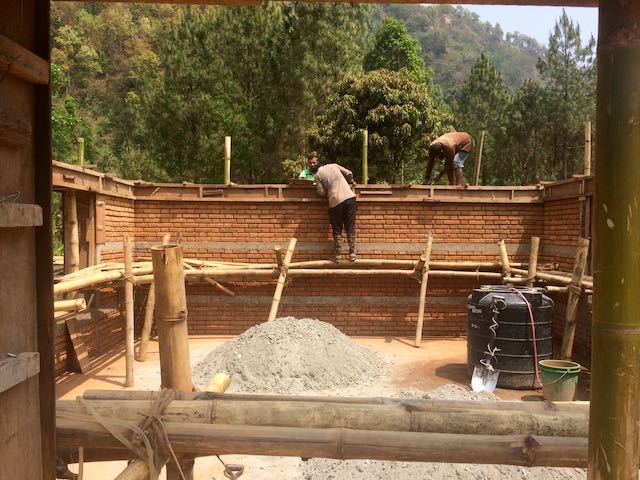 • Navigating the various government offices to gain the full approvals for our preferred safe eco building methods; calming upset neighbours that our projects will not infringe on their land and views;
• Navigating the various government offices to gain the full approvals for our preferred safe eco building methods; calming upset neighbours that our projects will not infringe on their land and views;
• Rebuilding 8 permanent classrooms, with 4 more under construction;
• Helping relocate temporary school buildings so that permanent rebuilding can get underway; affirming with school committees and parents that we are supporting both education and the schools into the long term;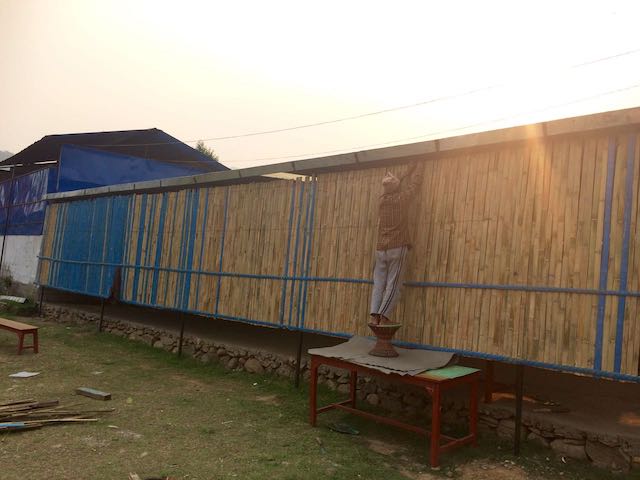 • Moving house in our Annapurna Children
• Moving house in our Annapurna Children
Home and completing full child welfare audits to prove that our care of children meets the highest of standards;
• Successfully negotiating and mediating with a bullying group which was determined to take funds from one of our women’s cooperatives, and ending the year with positive financial outcomes and an expanded program;
• Initiating our rebuild project that is providing both skills and examples of earthquake resilient buildings in village communities;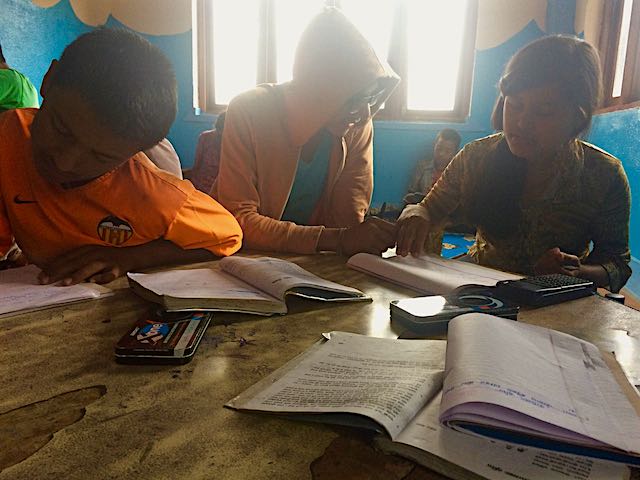 • Safely retrofitting engineering of our Bhaktapur children home that was badly damaged in the earthquake, and moving our children out of tents and back into safe buildings.
• Safely retrofitting engineering of our Bhaktapur children home that was badly damaged in the earthquake, and moving our children out of tents and back into safe buildings.
• Expanding and continuing the development of our organic agriculture that directly create food security for our Children Home as well providing life skills education.
This has been a deeply personal journey for me, both to experience a major disaster and to be part of the restoration. I had always known an earthquake would come while I was here, given that Nepal is located in one of the seismic hot spots of the world - and that I visit here a lot. Yet the experience has marked me in ways I did not imagine. I do not now take it for granted that the earth beneath my feet will stay stable. I now look at buildings in depth to see their structure and damage and future stability. I speak my mind much more freely when I see unsafe structures. I willingly ask for financial help to support my friends in Nepal to build safely. I embrace my own and other vulnerable human lives with more love, knowing how precious indeed being alive is, no matter where we are.
We human beings do tend to choose susceptible landscapes on which to build our homes and cities. Nepal is not unique in this. Some countries have more developed building codes and regulations, and the capability of enforcement to ensure safer buildings. Two years on, Nepal is still struggling with forming clear building and engineering guidelines, and with finding enough people with the understanding to build, oversee, and enforce safe changes.
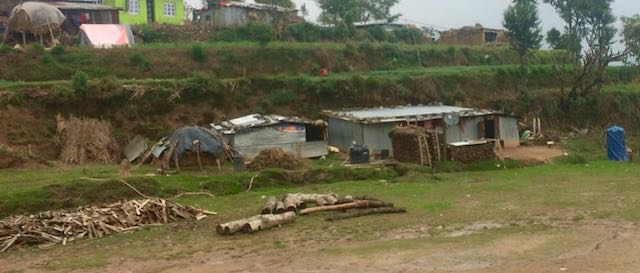 Published in the past weeks are numerous critical articles about both the government of Nepal and AID agencies, in regard to rebuilding post-earthquake. Understandably, many donors are upset that the millions of people made homeless after the earthquake are still living in temporary shelters two years on. More than 630,000 homes were totally destroyed and many more badly damaged and not safe to live in. More than 22,000 schools, and many health facilities, were destroyed – fewer than 5% have been rebuilt.
Published in the past weeks are numerous critical articles about both the government of Nepal and AID agencies, in regard to rebuilding post-earthquake. Understandably, many donors are upset that the millions of people made homeless after the earthquake are still living in temporary shelters two years on. More than 630,000 homes were totally destroyed and many more badly damaged and not safe to live in. More than 22,000 schools, and many health facilities, were destroyed – fewer than 5% have been rebuilt.
Here are some examples of recent challenges: It does take time for any government to oversee significant changes in building codes and implementation – let alone a government still moving into democracy and being pulled one way and another by its two super-power neighbours (India and China). But who would have predicted that just a few months after such a major disaster that India would cause a border blockade for eight months, effectively isolating Nepal from essentials such as fuel, medicines, food and basic building materials? Then of course there is the hard reality of the geography of Nepal and lack of accessible roads. Simply to evaluate the damage to homes and school took months, as many places affected were in remote areas accessible only by days of walking. Add into that mix numerous AID organisations, all wanting to help but not all sensitive to the cultural or geographical needs of the country. These are just a very few of the challenges that have led to a mixed outcome – fewer than 5% of buildings have been rebuilt in two years and thousands of unsafe buildings still require deconstructing.
Yes, it’s complicated! I can fully understand why there are so many critical articles these weeks however I would add a cautionary note: nothing is ever black or white and at this time in Nepal there are most certainly a lot of grey tones!
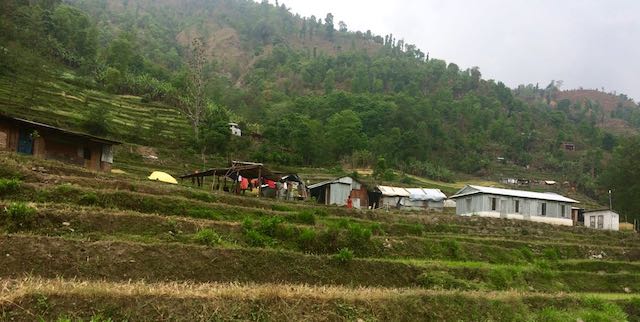 In the earthquake affected rural areas most people have now made their temporary homes from corrugated iron sheets and left overs from demolished homes. Although providing basic protection they are not durable solutions and tend to be either cold and damp or too hot - not ideal for healthy living.
In the earthquake affected rural areas most people have now made their temporary homes from corrugated iron sheets and left overs from demolished homes. Although providing basic protection they are not durable solutions and tend to be either cold and damp or too hot - not ideal for healthy living.
Many people do not have the resources or knowledge to rebuild safely. This inspires our initiation to provide training and technology in the hands of villagers so they can rebuild one school one house at a time. This is a long term initiative.
On a practical level it is clear that there is no way to rebuild all these structures in a short time, no matter how strong the wish may be to do so. Even if there were unlimited resources, the scope of work required is immense and will take at least the next decade. It touches my heart each time I visit friends in the temporary shelters they have lovingly made “home.” I want to build a new home for everyone! But I know that real help does not work that way. Through my years (17 now!) of working with my Nepali friends in various projects in education, children’s and women’s welfare, and organic agriculture, I have learned many good lessons. The most important is to respect the local knowledge and support empowerment of local people through education and skills development.
Hence, my approach to helping rebuild focuses on placing the skills and power in the hands of the people by these means:
1. On-the-job training to enable local villagers to build their own homes, providing the tools and skills they need to build safely;
2. Use of local materials (earth/mud, bamboo/wood) as much as possible to enhance sustainability and reduce costs;
3. Earthquake resilient building technologies that is easy to learn and use;
4. Meeting government approvals and engineering requirements (this enables villagers to access government grants for building);
5. Providing culturally appropriate building styles that look great!
A big thank you to Nripal Adhikary and his team at ABARI for doing the technology ground work and ongoing supervision for this type of rebuilding in Nepal. And a big thank you to Neel, Bikash & Rajan of TEAM Nepal for their local coordination and implementation of this initiative.
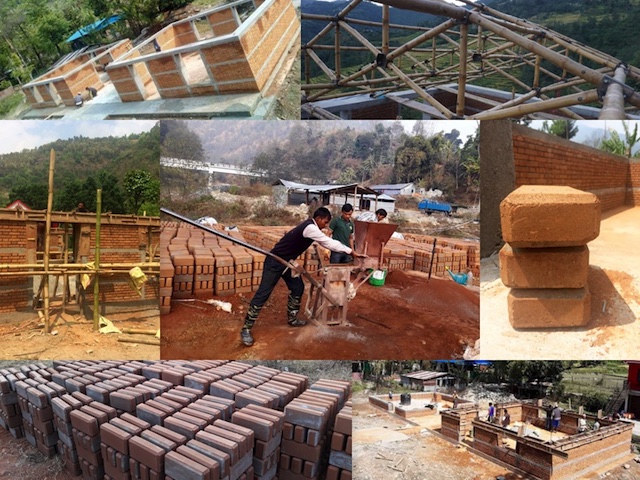
Education to make compressed earth bricks from local mud, reduces costs and places power of rebuilding in villagers hands - literally! On-the-job training enables local villagers to build their own homes, providing the tools and skills they need to build safely.
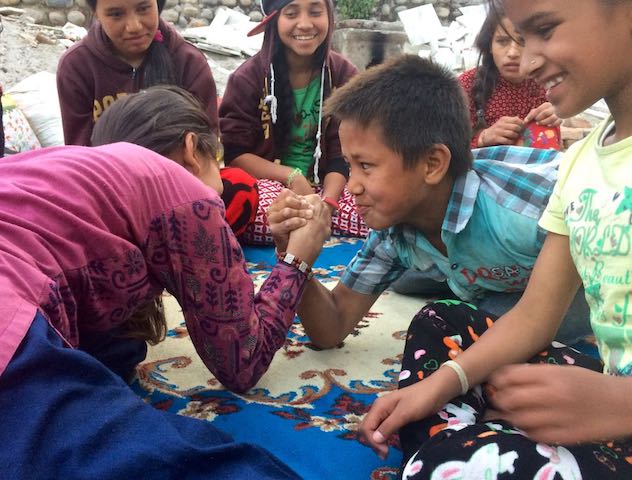 I am lucky. I have awesomely honest and transparent Nepali friends who are providing excellent relationship building and resource management to ensure that what we are doing really does have long-term effect and sustainability. There have been challenges of course! A country that has been in massive transition for the past two decades, and now is recovering from a massive disaster is, understandably, a complex environment to work in. What I find the most helpful in navigating the challenges are diligence, patience, LOTS of communication, and an open mind.
I am lucky. I have awesomely honest and transparent Nepali friends who are providing excellent relationship building and resource management to ensure that what we are doing really does have long-term effect and sustainability. There have been challenges of course! A country that has been in massive transition for the past two decades, and now is recovering from a massive disaster is, understandably, a complex environment to work in. What I find the most helpful in navigating the challenges are diligence, patience, LOTS of communication, and an open mind.
Working with people I trust by organically building relationships over time and shared experiences, and seeing whether this person or community is reciprocating trust and honesty, has left me with confidence in facing whatever arises. By having a reliable team of local people, I can more deeply understand the complexities and not become overwhelmed when challenges arise. And most certainly post-earthquake complexities abound!!! Yet, by understanding the key issues more deeply, I realise that some of these challenges are necessary, while some are a result of the wider geopolitical situation. This allows me to be sensitive to what I can do and acknowledge what I cannot.
Nevertheless, and despite great challenges, again and again I see the perfection in what unfolds, one step at a time. As I discuss with my Nepali friends the various issues we have faced, they talk about what they have learned and grown through, what they see within themselves and the situation. I can certainly say the same for myself. The consistent practice of taking a step back to breathe and give space for what I do not know has been a perfect tool these past two years.
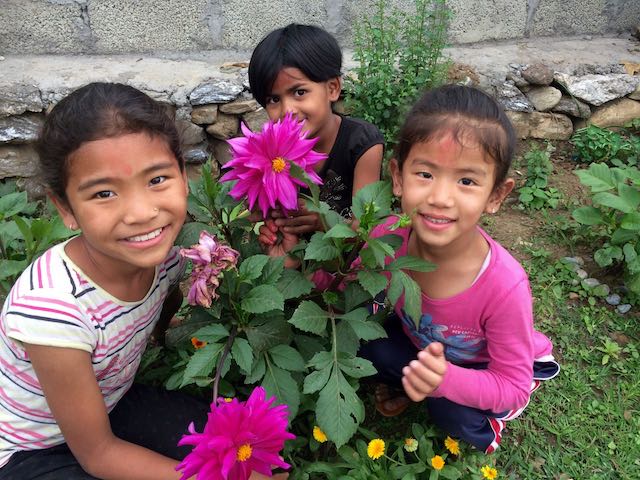 I can honestly share with all my friends and donors that your funds have been used effectively, and continue to give support where we have used them. Witnessing our children evolving and maturing into responsible adults is deeply touching to my heart. Seeing the schools able to conduct classes despite the limited infrastructure is awe-inspiring. Please feel free to come and see for yourself, and experience the rewards. If you would like more information about anything I have written here, or about a specific project, please be in touch.
I can honestly share with all my friends and donors that your funds have been used effectively, and continue to give support where we have used them. Witnessing our children evolving and maturing into responsible adults is deeply touching to my heart. Seeing the schools able to conduct classes despite the limited infrastructure is awe-inspiring. Please feel free to come and see for yourself, and experience the rewards. If you would like more information about anything I have written here, or about a specific project, please be in touch.
Many of you who are reading this have been generous with donations right after the earthquake. This truly enabled us to deliver important and effective emergency support. Some of you have continued to donate, which has enabled us to start the rebuilding projects, fully repair our earthquake-damaged Bhaktapur Children Home, as well continue our regular initiatives. This has been such a great help and thank you!
I still require funds to continue what we are doing. The emergency phase is certainly past but the rebuilding will take time and it does take regular financial help, as do our long-term initiatives. I appreciate direct introductions to foundations and other funding bodies if you have contacts. And of course any donation, small or large, is helpful. Aside from accounting fees all funds arrive directly here in Nepal and are used under supervision. I personally donate all my own time and travel expenses as I consider this my giving back to my world, and a great opportunity to grow and evolve as a human being.
If you have any questions about my own experiences, the projects I am involved with, the general safety in Nepal – please be in touch! I feel as if I could write a book on all that I have witnessed and experienced these past few years and I have captured here simply some key points. I hope you have enjoyed my musings.
One year on from the 2015 Nepal earthquakes – what is it like now?
Written by kira kay on 28 April 2016.
I am thankful that I was in Nepal exactly at the time of the 7.9 Earthquake on April 25th 2015. While it was shocking and traumatic, being present with the immediate effects of the earthquake gave me a depth of empathy and understanding for the physical destruction and psychological consequences.
I’ve spent almost six months in Nepal since. My love for this country and its people has deepened through witnessing such resilience in the face of hardship, so much kindness and working together. At the same time, it’s heartbreaking to witness the confusion and dysfunctions on government, INGO, private and local levels in ensuring rebuilding ... To put it very simply, it’s complicated!
The Sindhulpalchok District is an area I’ve grown to love over 15 years of collaborating with Neel Shahi (TEAM Nepal) in various school projects, and was one of the ones most affected by the earthquakes. More than half of the deaths occurred there, and well more than 85% of homes and schools there were totally destroyed.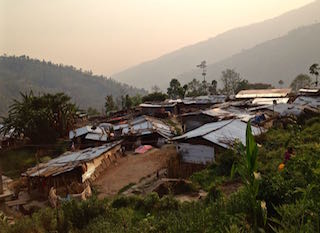
Taking friends to visit has been challenging – pointing out the tin shelters and tents that are the temporary homes of the local villagers, then identifying piles of rocks with weeds already growing in them as their former homes, schools and businesses; explaining that the big swaths of gravel on the hillsides are recent landslides triggered by aftershocks and have displaced whole villages, covered roads, and cut off access; revealing that many water supplies have dried up as the earth has shifted, making daily life and agriculture more difficult and time consuming; pointing out that, as a consequence of infrastructure damage, electricity supplies are sometimes limited to 8 hours a day.
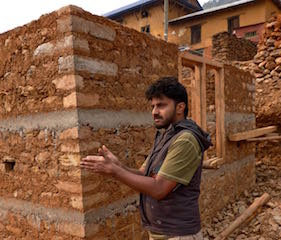
I’ve heard the stories of many Nepali friends who lost their homes and family members. Many have also lost their livelihoods, personal possessions, legal documents and more – so much simply lost in the rubble and dust. Yet the smiles and the willingness to work to rebuild remain, even if the vulnerability is very alive in their eyes.
The scale of rebuilding Nepal is massive and has hardly begun. Hundreds of thousands will live another monsoon (June-August) in temporary shelters. By now those shelters have a look of “home” about them, but that doesn’t change the reality that they are stifling hot in the summer and chillingly cold in the winter. People often walk hours to ensure water supplies for survival, and many have worked hard and planted their seasonal crops. If you ask them about their situation they frequently reply with a big smile, “ke garne?” – “well, what to do?” – and carry on.
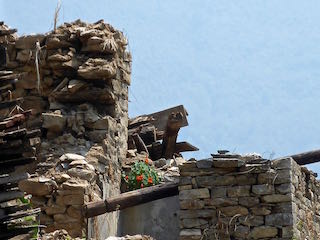
The one point international seismologists agree on is a strong probability of another big earthquake in matter of years. In my mind, the consequences of this are much more catastrophic than the 2015 Earthquakes. So I turn my focus to rebuilding safely.
Our first “on-the-job” earthquake-resilient, eco-rebuilding training is currently underway! Eight classrooms at Naryansthan Higher Secondary School and one Example residential Home building. We’re constructing the school buildings with compressed earth bricks (CEB) made on location from local mud and sand. The roof is bamboo truss and matting with CGI sheets for waterproofing. The Example Home is constructed from local stone with engineering techniques that ensure earthquake resilience, and the government-approved designs can be replicated throughout Nepal. Our aim is to blend what villagers already know with proven techniques to show what is possible.
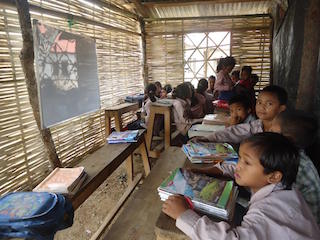
Our first experiential project will complete by June and our next location will begin directly after the monsoon. We continue working and sharing knowledge with on-the-job trainings, building manuals in local language, and vocational training centers. I follow up with talks with youths to engage younger minds and bodies in their own futures. These may seem only small steps considering the scale of rebuilding required, but as mountain people well know, every step matters!
Our DOMO tents continue to serve as secure, safe shelters for our children in Sipadol village while their Home is being repaired. Children in Talamarang are living in a DOMO student Hostel enabling them to attend school. Our various other long-term initiatives – children homes, microcredit, agricultural trainings, computer labs and libraries for schools – continue to develop and contribute to the lives of Nepalese people. Witnessing the empowerment and uplifting of lives is truly a gift.
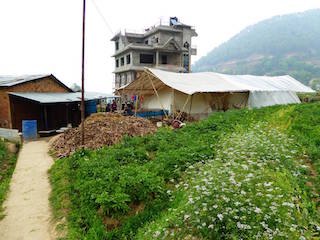
I love Nepal – the culture, the nature, the sense of community and humanity that, in our Western cultures, we’ve sometimes lost touch with. The open-hearted people of Nepal inspire me.
I heartily encourage you to visit Nepal! If you keep in mind that you are visiting a country that has recently undergone a major natural disaster, you will likely keep yourself safe and also make a much-needed contribution to the local economy. Visiting, whether for tourism or adventure, can help this country regain its economic stability. If you’re a business-minded person, consider a potential business partnership. (Nepal’s carpets and handicrafts are world-renowned!) Further earthquakes are highly probable, so if you have health considerations or experience anxiety easily, look at supporting in other ways.
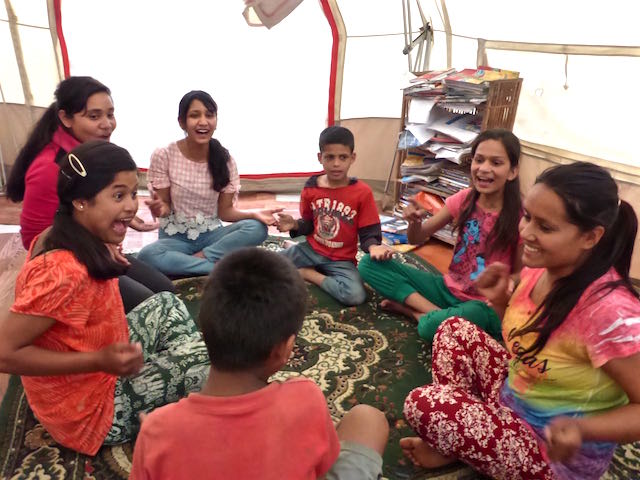
Super big thanks to everyone who has helped me/us in this past year since the Earthquake. I sincerely wish that you stay in touch and continue to help however you can to enable our continued work in Nepal.
Heartfelt greetings, Kira
ps my own contribution and work in Nepal is entirely voluntary and self funded, and many others volunteer of their time and resources to help HwH projects in Nepal – meaning that aside from very basic administration costs all donations directly support in Nepal.
Our current Activities in Earthquake Response/Relief
Written by kira kay on .
A really big Thank You – Dhanyabad – Dankeschön – to all of you! It has been with your generous donations that we swiftly coordinated with our Nepali friends emergency relief responses after the earthquake, and consistently in the months since.
With your help we have provided a range of emergency support immediately post-earthquake:
* Emergency food and safe water sources
* Temporary shelter/toilets
* Medical supplies to support a health camp in Sindhulpalchok since the day after the earthquake and ongoing till now
* Care packages for mothers and young children, including food supplements
* Provision of solar technology to support emergency communications
* Help in building temporary schools to facilitate ongoing education 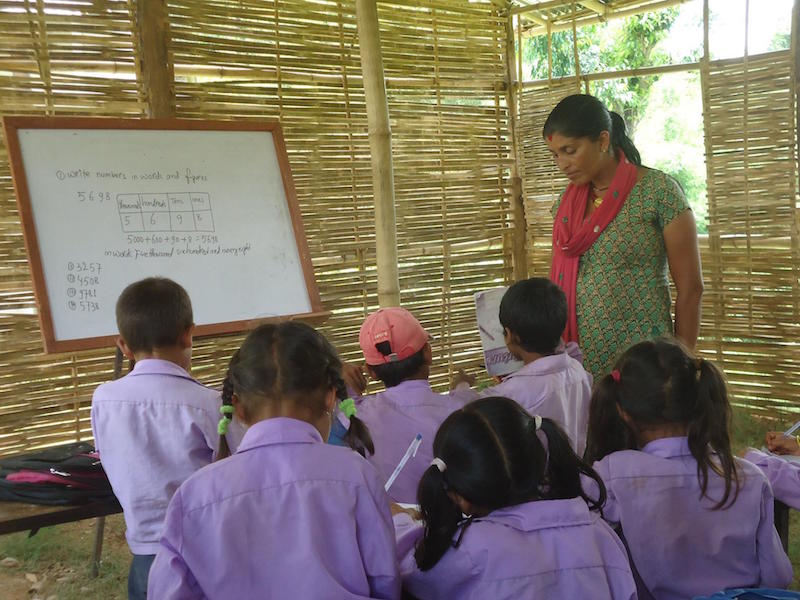
* Purchase and distribution of education materials, including essential textbooks destroyed in the earthquake
* Creation of a temporary student hostel as a safe home for children to continue attending school
It has been incredibly heart warming to get the news reports back from our friends in the field and to see the smiles and gratitude of the recipients.
Details of our support can be found on our news page: "news update" page.
Our ongoing activities in Earthquake Response/Relief:
1. Continued collaboration with our Nepali friends/teams to maintain emergency relief as required.
2. We are providing ongoing extra support for our Bhaktapur Children Home in Sipadol as we undertake major restructure repairs to our damaged buildings. The rebuilding with experienced engineers will begin in October and will take 6-7 months to be completed.
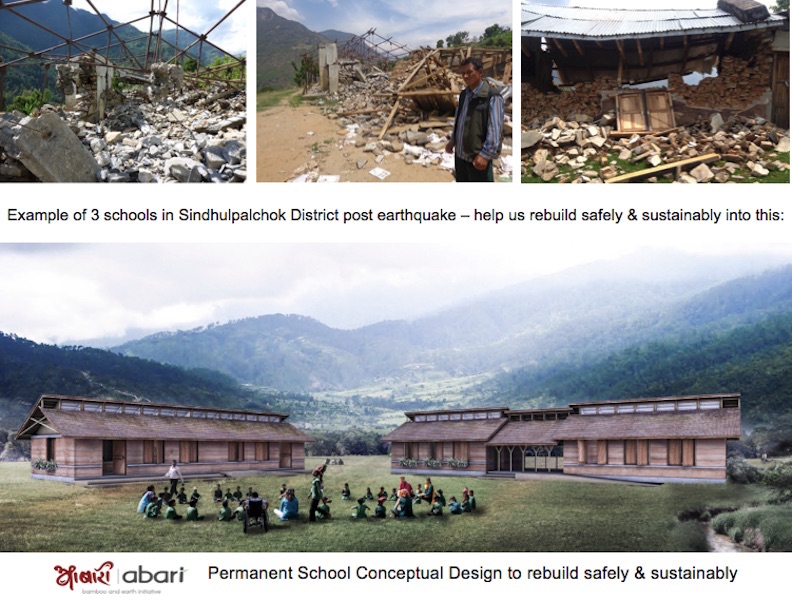
3. Together with TEAM Nepal NGO (Neel & Bikash Shahi) and local Nepali eco-building company Abari (www.abari.earth) we are supporting general rebuilding initiatives in the most affected of communities. Additionally Abari will oversee the safe eco-construction of permanent new schools/homes in our sustainable/whole village approach - see below for full details.
4. In our microcredit project in Chitwan district we are already working with the most needful communities. This support includes; the repair/rebuilding of homes and expansion of our current training/development programs in order to establish a small agricultural business that will sustain and support families into the future with secure food supplies. 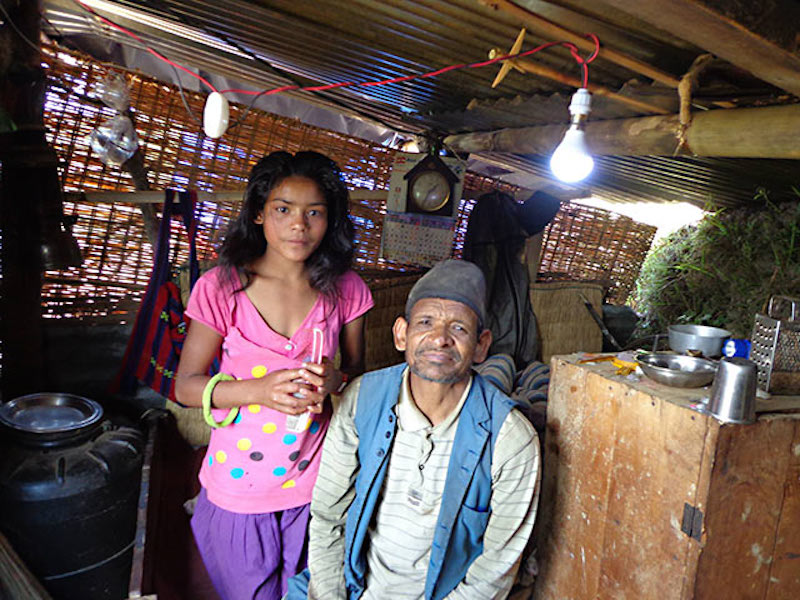
5. In conjunction with Sibjan Chaulagain’s SMILES NGO team we continue, in the Sindhuli district, support for emergency relief and sanitation/water projects for the rural communities, plus expansion of ICT for agriculture development. We will also be supporting with the provision of organic seed stock to replenish that which was lost during the earthquake. Into the future we will also be involved with the school rebuilding with the Abari team in this district.
6. In conjunction with Nepal solar company "Surya Power Eco Solution Pvt. Ltd." we are supplying and installing to rural areas most affected by earthquake, basic solar systems to provide essential lighting and facilitate charging of communication devices.
*** additional supporting projects are under discussion and will be added when confirmed ***
Details of our Rebuilding Schools/Homes
with Abari (pt 3 expanded) - next steps:
Education and training: in conjunction with local communities, our local Nepali NGOs, and sustainable construction company Abari, we will be implementing community-driven rebuilding, initially focusing on the destroyed school in the selected village(s). By using the advanced skills and technology of the Abari team we will provide the villagers with training in basic construction skills such as masonry, carpentry, plumbing and electric. The focus is on sustainable and government approved earthquake-resistant techniques/designs that incorporate traditional styles and knowledge.
Provision of tool libraies and workshop spaces: This allows for safe buildings to be rebuilt locally, in a scale and at a pace that individuals can meet. We aim to provide additional training in building and craftsmanship – for example furniture making and building of tourism homestays – this can enhance the economic potential of the villagers.Additionally these workshop spaces can become integrated parts of the schools offering longterm vocational training.
Improve Community Forests: with local communities we aim to ensure sustainable building-specific trees/bamboo are planted. This will also help to reduce landslides and soil erosion, plus provide healthy carbon retainment, all of which can potentially improve economic potential and further ecological consciousness.
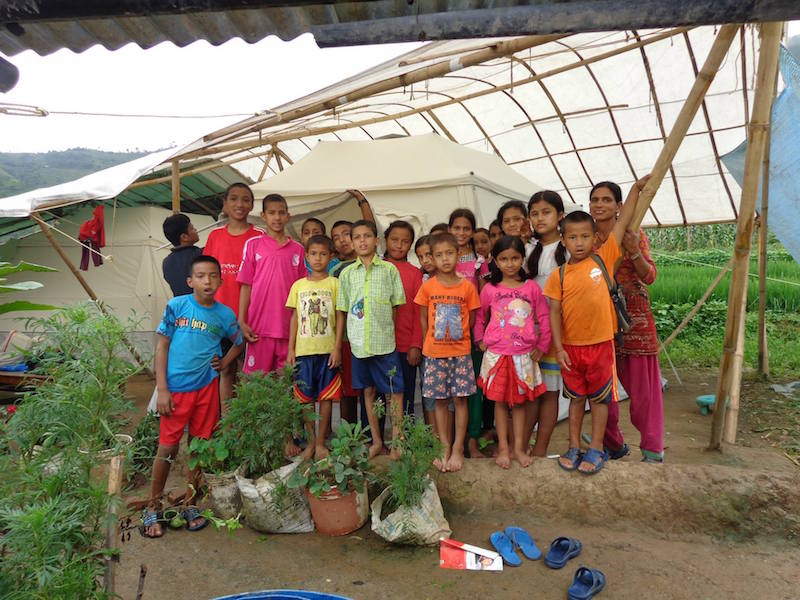 Reduce donor dependency: Historically (Haiti, Tsunami Sumatra, Hurricane Katrina), we’ve seen that the time after disaster can lead to high dependency on donor funds (INGO/Government) for basic survival, which in turn can lead to dysfunctional economy and splintering of communities. We trust that our initiatives will alleviate these issues and help towards healthy, self-sufficient communities with safe building into the future, and economic and agricultural add-ons that further contribute to sustainability.
Reduce donor dependency: Historically (Haiti, Tsunami Sumatra, Hurricane Katrina), we’ve seen that the time after disaster can lead to high dependency on donor funds (INGO/Government) for basic survival, which in turn can lead to dysfunctional economy and splintering of communities. We trust that our initiatives will alleviate these issues and help towards healthy, self-sufficient communities with safe building into the future, and economic and agricultural add-ons that further contribute to sustainability.
Contributing to the development of resilient communities; supporting safe and healthy structures for education to continue; helping local economies revitalize and develop capacity and sustainability into the future – these are key outcomes we hope to achieve in our efforts.
Hands-with-Hands and Abari’s first collaborative initiative jointly with Sathsathai Mundi Foundation will begin in October/November 2015 in the village of Timal, district Kavre. Our next location in Sindulpalchock is in discussions and we hope to have that next initiative underway in December/January and further schools into 2016.
We will need your help to finance this initiative, to provide the tools, technical developments, expertise and labour to achieve these goals. Thank you for donating and helping us help rebuild schools safely in Nepal!
Once again a huge heartfelt thank you to all donors for helping us help in Nepal! Additionally, your support gives renewed energy to our many Nepali friends working in the field and inspires them to continue helping others.
Insights into situation in the field in Nepal
Written by kira kay on .
Right now I am sitting on a plane — with a great deal of mixed emotions. Thankful to be safe, overwhelmed with what is still unfolding in Nepal and feelings of immense helplessness.
In talking with my Nepali friends I realised it is much better that I leave and help coordinate support and logistics from outside Nepal. Aside from the simple reality that communications are greatly impacted & limited at present, there is also the reality that "taking care of foreigners" is the last thing the Nepalese need right now. Ever generous the Nepalese people are offering foreigners' food and water first when these items are fast become very, very scarce in the capital cities of Kathmandu, Bhaktapur and Lalitpur.
Some picture takes on the day of the earthquake, the 25th of April 15:
There is a very great need for immediate emergency support and longer-term rebuilding/infrastructure support, both of which require a lot of funds and practical logistic support. I am very thankful that over the past 15 years of being involved in social welfare projects in Nepal I have developed an extensive network of inspiring and integral Nepalese friends.
Many of these friends are already out in the field delivering emergency support in the most critically hit rural regions. Additionally they are already thinking and planning for the longer term.
Pictures taken by Kira Kay in Kathmandu on the day after the earthquake, the 26th of April 15:
During the Earthquake itself I was with our children at our Children Home in Sipadol village, in the hills above Bhaktapur. We happened to all be outside sitting on the carpets eating fruit that I had brought with me, looking through the new schoolbooks and playing when the quake struck. Thankfully it was easy for us all to run to the fields and be safe.
It was quite terrifying to watch our own house building sway and shake and the ground beneath us bubble and roll. Within moments we could see red dust clouds about the village, hills and covering the city of Bhaktapur, signifying the immediate collapse of buildings. Thankfully, in the Sipadol village where our Children Home is located, there were no casualties or deaths.
Over the past few days I have been able to contact all our various project locations in different regions of Nepal and established that they are safe. I am immensely thankful that no one close to me has suffered major injury or death, however many have lost their homes and two of our Children Homes are badly damaged, along with some school buildings. I am totally blown away by the people here in Nepal and their attitude. I wish I could transport some of the very special moments I have experienced the past days.
Here are some pictures from the Bhaktapur children's home on the 1st of May 15:
Some short notes for now, that I will follow up in more detail in the days/weeks to come:
- Millions of people are directly affected by the Earthquake. The number of people I have personally met in these few days since the quake whose entire village of hundreds of homes has been entirely flattened is staggering. The death toll and injuries will rise much further in the next days & weeks as rescue/support reaches communities that are only accessible by walking. I know these regions well; several of our projects are located in the most devastated areas and so far, in all these locations, no government/international aid support has reached them as of 3 days post quake.
- In the urban locations most affected, the aid/support is still far from what is required. I spent the past two days walking the streets of Kathmandu talking with local people and seeing with my own eyes the devastation. It is not only the crumbling of older buildings, and some new ones — the obvious impact — many locations do not yet have rescue teams attempting to remove bodies and locate survivors. Plus so many more buildings, I would estimate 30-40%, are now critically cracked and structurally compromised and not safe to live in. Basic necessities such as water, food, shelter and fuel supplies are already, after 3 days, critically compromised. The potential of secondary crisis from disease and lack of basic survival needs is very high. I have several young friends with young babies only two months old, who are finding the conditions extremely challenging. Presently 70-80% of the population in the cities are camped out of doors for safety.
- The aftershocks (more than 200 so far), and the uncertainty as to whether there will be further major quakes, is very real. In the two days after the quake, severe secondary quakes, not as strong as the initial 7.9 , yet powerful enough to continue the destruction and deepen fears, have contributed to the continuing crisis.
- The fact that so many buildings - including many primary care building such as hospitals and government services, banks, food supplies – have been damaged and structurally compromised, directly impacts both the immediate support and longer term recovery in the cities.
- Several of our Hands-with-Hands project buildings (two of our Children Homes and several school buildings) have been badly affected. All our children and staff and friends are safe and uninjured for which we are immensely thankful and grateful.
- There is a huge immediate need for temporary shelter and emergency supplies of food and water, as well as medical support, in the rural communities, plus the long-term needs of rebuilding.
What we are already doing:
- My Nepali friends and their local volunteers are already in critically affected areas with tents, medical teams, medicines and basic food/water supplies. I have assured them that I/we will back them up with financial support so they can carry on and do what is needed without thinking about the costs.
- Some of my Nepali friends are directly supporting and helping with the children affected in the primary impact areas in both medical assistance and primary care – shelter, food, water, and love.
- We are already making plans for the next stage of support after the immediate survival needs are met. The development and education is towards eco friendly earthquake resistant construction. We already had this project underway in a small way and need help to upscale and outreach very fast to prevent this devastation from reoccurring. We are working directly with Nrirpal Adhikary who is Nepalese and has developed bamboo and natural earth building in modern techniques. I will share more on this in the next days/weeks, right now our focus is on emergency supplies.
There is no big organisation behind me/us. Up until now I have relied upon individual friends and family for donations here, and there, as needed– but this is way bigger than anything I could imagine and I implore you to support me/us. 100% of donated funds will be landing on the ground, of that I can guarantee. For 15 years myself and several of my Nepal friends have been contributing our time and personal resources as volunteers.
We continue to do so in this situation and have engaged already a number of other friends, at this time, to do the same. Your help is really appreciated and I am also so thankful for the overwhelming number of messages already sent by many of you – please know I will respond as soon as is practical.
I am currently relying on friends who have set up additional places for receiving donation, in addition to the primary places of our HwH German Bank account and a PayPal account. I hope within the next week to have more options and also a better source/flow of information about what is unfolding in Nepal, both our impact and the reality of the situation on the ground.
I am heading now to Australia where I will coordinate funds and logistics. I will send another update when I can.
With heartfelt gratitude & appreciation,
Kira
Donations can be made by:
- By sending to our German Bank account
Account name: Hands with Hands e.V.
Bank: GLS Gemeinschaftsbank eG - address: Christstraße 9, 44789 Bochum, Germany
IBAN: DE46 4306 0967 1135 8729 00
BIC: GENODEM1GLS
(receipt for tax within EU available if donations made to this account, please mention your address.) - Via PayPal click here



























































